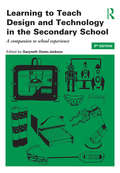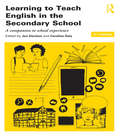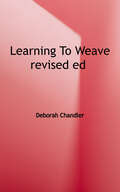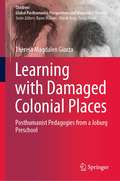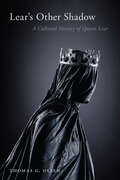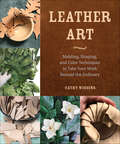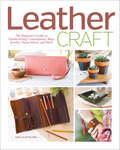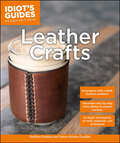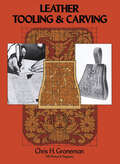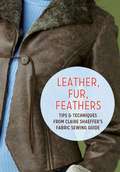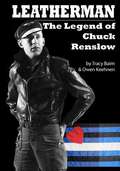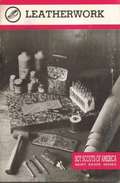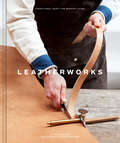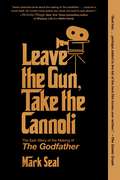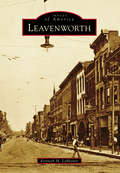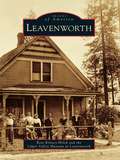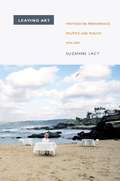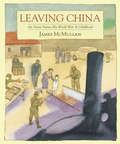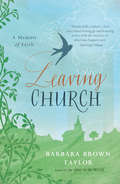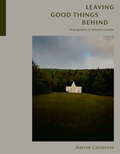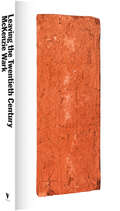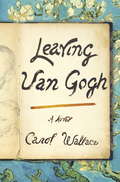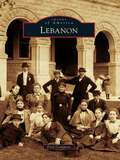- Table View
- List View
Learning to Teach Design and Technology in the Secondary School: A companion to school experience
by Gwyneth Owen-JacksonLearning to Teach Design and Technology in the Secondary School is established as a core text for all those training to teach Design and Technology in the secondary school. It helps you develop subject knowledge, acquire a deeper understanding of the role, purpose and potential of Design and Technology within the secondary curriculum, and provides the practical skills needed to plan, teach and evaluate stimulating and creative lessons. This third edition has been fully updated in light of the latest curriculum, policy and theory, as well as exciting changes in the field of design and technology.? Designed to be read as a course or dipped into to for support and advice, it covers: Developing areas of subject knowledge Health and safety Planning lessons Organising and managing the classroom Teaching and learning with digital technologies Teaching wider issues through design and technology? Assessment issues Your own professional development. Bringing together insights from current educational theory and the best contemporary classroom teaching and learning, this book will prove an invaluable resource for all student and newly qualified teachers – as well as their mentors - who aspire to become effective, reflective teachers.
Learning to Teach English in the Secondary School: A companion to school experience (Learning to Teach Subjects in the Secondary School Series)
by Jon Davison Caroline DalyHow do you approach teaching English in the contemporary classroom? What is expected of a would-be English teacher? The fourth edition of this best-selling text combines theory and practice to present an indispensable introduction to the opportunities and challenges of teaching English in the secondary classroom. It offers insight into the history, policies and definitions surrounding the subject, together with innovative and practical strategies which can be used for effective teaching and learning. Already a major text for many university teacher education courses, the new edition reflects the extent and impact of current reforms whilst retaining its focus on what is of enduring value for English teaching. With an emphasis on developing your own values and on stimulating approaches that underpin English teaching, it will help you navigate your way through changing curriculum requirements, assessment practice and the demands of professional development. Key topics explored include: Reading, writing and speaking and listening Teaching language and grammar Drama in English teaching Poetry Working with digital technologies Post-16 English language and literature Developing as a critically reflective practitioner. Written particularly with the new and student teacher in mind, Learning to Teach English in the Secondary School aims to equip readers with the tools to make critically informed judgements about how to teach, develop principled practice and most importantly, be mindful of pupils and their experience of English in the secondary classroom.
Learning to Teach Music in the Secondary School: A companion to school experience (Learning to Teach Subjects in the Secondary School Series)
by Carolyn Cooke, Keith Evans, Chris Philpott and Gary SpruceThis 3rd edition of Learning to Teach Music in the Secondary School has been thoroughly revised to take account of the latest initiatives, research and scholarship in the field of music education, and the most recent changes to the curriculum. By focusing on overarching principles, it aims to develop reflective practitioners who will creatively and critically examine their own and others’ ideas about music education, and the ways in which children learn music.Providing an overview of contemporary issues in music teaching and learning from a range of perspectives, the book focuses on teaching music musically, and enables the reader to: place music education in its historical and social context consider the nature of musical knowledge and how teachers can facilitate their students to learn musically critically analyse the frameworks within which music teachers work develop an understanding of composing, performing and responding to music, as well as key issues such as creativity, individual needs and assessment examine aspects of music beyond the classroom and how effective links can be made between curriculum music and music outside of school. Including a range of case studies, tasks and reflections to help student teachers integrate the theory and practice of music education effectively, this new edition will provide invaluable support, guidance and challenges for teachers at all stages of their careers, as well as being a useful resource for teacher educators in a wide range of settings.
Learning to Weave
by Deborah ChandlerOriginally published in 1995, more than 40,000 weavers have used this unparalleled study guide to learn from scratch or to hone their skills. Written with a mentoring voice, each lesson includes friendly, straightforward advice and is accompanied by illustrations and photographs. Crafters need only to approach this subject with a willingness to learn such basics as three methods for step-by-step warping, basic weaving techniques, project planning, reading and designing drafts, the basics of all the most common weave structures, and many more handy hints. Beginners will find this guidebook an invaluable teacher, while more seasoned weavers will find food for thought in the chapters on weave structures and drafting.
Learning with Damaged Colonial Places: Posthumanist Pedagogies from a Joburg Preschool (Children: Global Posthumanist Perspectives and Materialist Theories)
by Theresa Magdalen GiorzaThis book offers a close and detailed account of the emergent and creative pedagogies of children learning together in a small, not-for-profit preschool, and the entangled becomings of their carers as well as the researcher–artist–author. The mutually affecting and inseparable realities of the ‘material’ and the ‘discursive’ are made visible through lively and sensual pedagogical invention by a group of five-year olds in the inner-city preschool which is located in Johannesburg, South Africa. These small, local stories are recognized in their emergence with global geopolitical realities. The author makes a valuable contribution to post-qualitative research through the use of visual research methods and non-representational approaches to working with knowledge. The book draws on the constantly evolving practices of Philosophy for Children (P4C) and Reggio Emilia both as pedagogical tools and as research methods. Photographs and stills from video footage provide a sense of the relatively modest material environment of the school. The book celebrates the considerable richness of the involvement of the children and the enormous possibilities offered by the world both inside and outside of the classroom when an enquiry-led art-based pedagogy is followed. Drawings and other products created by the children in the study offer valuable insight into the depth and complexity of their engagement with their worlds, both individual and collaborative.
Lear’s Other Shadow: A Cultural History of Queen Lear
by Thomas G. OlsenLear’s Other Shadow: A Cultural History of Queen Lear offers a deep cultural analysis of the figure of Queen Lear, who shadows and eventually sometimes overshadows her royal husband across the nearly one-thousand-year life of this archetypal tale. What appears to be a deliberate strategy of suppression, even erasure in Shakespeare’s King Lear later inspired dozens of stage, page, and cinematic remakes and adaptations in which this figure is revived or remembered, often pointedly so. From Jacob Gordin’s Yiddish-language Miriele Efros (1898), through edgy stage remakes such as Gordon Bottomley’s King Lear’s Wife (1915) and the Women’s Theatre Group’s Lear’s Daughters (1987), to novelized retellings from Jane Smiley’s A Thousand Acres (1991) to Preti Taneja’s We That Are Young (2018) and J. R. Thorp’s Learwife (2021), and even the television series Empire (2015–2020) and Succession (2018–2023), Queen Lear regularly emerges from her shadowy origins to challenge how we understand the ancient King Leir/King Lear story. These and many other examples reveal fascinating patterns of adaptation and reinterpretation that Lear's Other Shadow identifies and analyzes for the first time, showing how and why Queen Lear is at the center of this ancient story, whether she is heard from or not.
Leather Art: Molding, Shaping, and Color Techniques to Take Your Work Beyond the Ordinary
by Cathy WigginsA popular designer teaches 18 projects to help turn your basic leather creations into head-turning artistic statementsFor leather crafters who don't need more patterns but instead want to add artistic impact to their workWiggins's leather art is found in high-end homes, museums, and even Las Vegas hotel casinos
Leather Bracelets: Step-by-step instructions for 33 leather cuffs, bracelets and bangles with knots, beads, buttons and charms
by Nihon Vogue-ShaThirty-three easy-to-make designs—from friendship bracelets to a braided metallic cuff. Mix and match to create your own personal style! Make the most of one of today&’s hottest jewelry trends with Leather Bracelets, a collection of thirty-three beautiful beaded, knotted, and braided accessories that would be at home on the shelves of the most stylish designer boutiques. Gorgeous worn alone but even more stylish stacked, these bracelets can be made with readily available leather cord and findings and a few basic jewelry-making tools. Each hand-crafted bracelet can be made unique just by changing the colors and chosen charms or beads. Sized precisely to fit the recipient, these bracelets are sure to please!
Leather Craft: The Beginner's Guide to Handcrafting Contemporary Bags, Jewelry, Home Decor & More
by Amy GlatfelterA classic craft reinvented for the modern maker! Love the luxe look of leather but intimidated by what seems like expensive materials, complex designs, and difficult techniques? Think again! Skilled artisan Amy Glatfelter teaches how to make fifteen gorgeous projects in leather using small cuts of material, easy techniques, and inexpensive tools. From buttery-soft clutches and totes to leather-wrapped planters and stylish jewelry, makers will learn to create a variety of updated classics that get better over time. Perfect for absolute beginners, this book starts with an overview of leather and the tools needed, step-by-step instructions, and ten essential leather crafting techniques. The ultimate beginner’s guide for an accessible and modern approach to leather craft! Step-by-step lessons for the ten essential leather crafting techniques, including how to cut and stitch leather, punch holes, set snaps and rivets and more Create a variety of home décor, jewelry, and personal accessory projects; each project includes detailed instructions, reference photographs, and a pattern
Leather Crafts: In-Depth Information on Tools, Materials, and Techniques (Idiot's Guides)
by Valerie Schafer Franklin Geoffrey FranklinA big part of the artisanal/DIY movement is about authenticity and quality, with a return to simplicity, real values, genuine materials, and careful craftsmanship. Leather is one of those authentic materials, and while it has always been used for handbags and gloves, it&’s also enjoying a resurgence in the field of crafts. Simple objects elegantly made of leather are featured everywhere on maker blogs, photo-sharing sites, tutorials, and craft marketplaces. Leather is in the real world, too, in heavily curated hipster boutiques and well-edited coffee shops that sell sundries. Idiot&’s Guides®: Leather Crafts offers 20 projects (illustrated with copious step-by-step photos), ranging from beginner to advanced, each one building on the skills that have been taught in prior projects. Unlike most existing books on leathercraft, which come with a heavy whiff of the &‘70s, this one has a sleek, modern aesthetic. The projects are functional, and the minimal, elegant embellishment and natural finishes will keep them timeless.
Leather Tooling and Carving
by Chris H. GronemanThis book by a well-known handicrafts instructor will teach you the fine art of leather tooling and carving so that you will now be able to make the handsomely crafted leather of handbags, belts, watchbands, and billfolds you have often admired. You will find that custom-crafted leather items are not only easier to make than you may have expected but also offer quite an enjoyable hobby.Many books deal with leatherwork in general but this book is one of the few that concentrate on tooling and carving. The author first introduces the various types of leather and tools, giving complete information on how to identify the superior sections of a hide and how to decide on which kind of leather is best for your purpose: kidskin for gloves, steerhide for billfolds, etc. Twenty-six different leather tools are depicted along with an illustration of the impressions the different kinds of stamping tools make. After this necessary background, the author covers the basic processes of leather crafting from start to finish: cutting and preparing the leather, transferring the design, tooling, carving, lacing, cleaning, dyeing, and finishing. This section is profusely illustrated with line drawings and photographs to make each step easy to master. You are now ready to begin the special projects, for which complete instructions and patterns are provided: bookmarks, key cases, coin purses, watchbands, billfolds, belts, shaving kits, camera bags, handbags, and cowboy accessories are just a few of the things you will be able to make.Hand-tooled leather items are quite expensive on the market, but you will find yourself with substantial savings when you make them yourself. What is more important, however, is that leather tooling and carving is an enjoyable craft that anyone can become adept at -- and this book will provide you with all you need to do just that.
Leather, Fur, Feathers
by Claire ShaefferLet internationally respected author, lecturer, college instructor and columnist Claire Shaeffer teach you how to wear, sew and care for three unique materials: leather, fur, and feathers. Packed with design ideas, sewing checklists, and helpful sewing notes that cover everything from darts to pockets, Leather, Fur, Feathers has all the information you need to get sewing!
Leatherman: The Legend of Chuck Renslow
by Tracy Baim Owen KeehnenA prominent Chicago gay activist and entrepreneur is the subject of an in-depth biography, Leatherman: The Legend of Chuck Renslow, by journalists and authors Tracy Baim and Owen Keehnen. Living as an openly gay man in 1950s Chicago was no easy task. For Chuck Renslow, that was only his first of many bold moves. Just out of high school he began what was to become a six-decade empire, starting more than two dozen businesses in Chicago, as well as a few in other cities. He has owned bars, discos, photo studios, health clubs, bathhouses, gay magazines and newspapers, hotels, restaurants, and bookstores. Throughout it all he dealt with Mafia and police payoffs, anti-gay political policies, harassment from censors, and even controversy within the gay community. In the mid-1950s, after having a portrait and then cheesecake studio, Renslow began experimenting with beefcake photography and began Kris Studio. With his longtime lover, the artist Dom Orejudos aka Etienne and Stephen, at his side, Renslow created Kris Studio a leader in male physique photography, resulting in such magazines as Triumph, Mars and The Rawhide Male, producing thousands of erotic images as well as several films. In 1959 Renslow took over the Gold Coast Show Lounge and transformed it into one of the most lowdown libidinous gay leather bars in the world. With Etienne's murals adorning the walls, a leather/Western/uniform dress code for patrons, and a dark Pit that featured all sorts of goings-on, the Gold Coast set the standard for raunchy kink and gay sexual liberation. It was the birthplace of motorcycle clubs and sex groups, but above all a place for people to meet, connect, and explore themselves and their sexuality. The Gold Coast was also the birthplace of the first leather contest, which in the span of a few short years evolved beyond the bar's capacity and became International Mr. Leather in 1979. More than three decades later, it continues to be one of the world's most popular gay events. Renslow was also one of the pioneers in taking a bathhouse beyond merely the borders of a mere sex club. Man's Country became something truly unforgettable in the 1970s - a sex-and-entertainment complex with a variety of rooms, shops, and a Music Hall that attracted top names touring in the "K-Y circuit," from Sally Rand to Wayland Flowers to Rusty Warren and Charles Pierce. Renslow was a dynamic force in Chicago politics under mayors starting with Richard J. Daley, and he ran to be a delegate for Sen. Ted Kennedy's 1980 presidential run. He danced with another man at a 1977 inaugural ball for Jimmy Carter. Renslow helped protest against unfair policies, fought censorship and entrapment, and battled Anita Bryant. He even served as a field contact for the pioneering work at the Kinsey Institute, as well as performing sexual acts for Kinsey researchers. He knew entertainment celebrities from Marlene Dietrich to Rudolf Nureyev, from Divine to Grace Jones, and from Sylvester to Quentin Crisp. In their heyday Chuck Renslow's annual White Parties were celebrations beyond compare. When Chicago's gay community faced the loss of its newspaper, Renslow bailed out and ran GayLife. He also co-founded the Leather Archives & Museum (with Tony DeBlase). Through it all Renslow has also been Daddy of the Family, a unique created group of lovers, tricks, and friends who were bound by sex and oftentimes love and by a goal of providing comfort and support to one another.
Leatherwork (Merit Badge)
by Boy Scouts of America StaffA handbook for earning a Boy Scout badge in leatherwork. Includes information about care, tanning, braiding, and making your own leather.
Leatherworks: Traditional Craft for Modern Living
by Otis IngramThe founder of Otzi London lays out the benefits and techniques of working with leather, including stitching, lacing, weaving, folding, riveting, and more.Learn to make beautiful items from leather, from homeware to fashion accessories, in your own living room. From a woven bench or log basket, to bags, a sunglasses case or even an apron, this cool craft book teaches you how to make twenty simple yet stylish leather projects. Master core craft skills that will allow you to produce elegant and durable pieces, such as hand-stitching, weaving, riveting and lacing. Learn all about working with this natural and sustainable material which has intrinsic value and gives unique character to each piece you create. Working with leather is a tidy, portable craft that requires little space and all of the tools and materials can be readily purchased—all you need is a small dining table! This book is the perfect introduction to working with leather.“Demonstrates just how straightforward it can be to work with leather at home.” —House Beautiful
Leave the Gun, Take the Cannoli: The Epic Story of the Making of The Godfather
by Mark SealThis &“wickedly pacey page-turner&” (Total Film) unfurls the behind-the-scenes story of the making of The Godfather, fifty years after the classic film&’s original release.The story of how The Godfather was made is as dramatic, operatic, and entertaining as the film itself. Over the years, many versions of various aspects of the movie&’s fiery creation have been told—sometimes conflicting, but always compelling. Mark Seal sifts through the evidence, has extensive new conversations with director Francis Ford Coppola and several heretofore silent sources, and complements them with colorful interviews with key players including actors Al Pacino, James Caan, Talia Shire, and others to write &“the definitive look at the making of an American classic&” (Library Journal, starred review). On top of the usual complications of filmmaking, the creators of The Godfather had to contend with the real-life members of its subject matter: the Mob. During production of the movie, location permits were inexplicably revoked, author Mario Puzo got into a public brawl with an irate Frank Sinatra, producer Al Ruddy&’s car was found riddled with bullets, men with &“connections&” vied to be in the cast, and some were given film roles. As Seal notes, this is the tale of a &“movie that revolutionized filmmaking, saved Paramount Pictures, minted a new generation of movie stars, made its struggling author Mario Puzo rich and famous, and sparked a war between two of the mightiest powers in America: the sharks of Hollywood and the highest echelons of the Mob.&” &“For fans of books about moviemaking, this is a definite must-read&” (Booklist).
Leavenworth
by Kenneth M. LamasterOn May 30, 1854, Pres. Franklin Pierce signed the hotly contested Kansas-Nebraska Act. Before the ink was dry, squatters settled on the 322-acre plot of land bounded by the Fort Leavenworth Military Reservation (to the north) and Three Mile Creek (to the south). From Bleeding Kansas to western expansion, many historical figures have called Leavenworth home, including Fred Harvey, Buffalo Bill Cody, and Wild Bill Hickok, to name but a few. The landscape is decorated with buildings and homes featuring a beauty and grandeur that have stood the test of time. Originally known as the �Queen City of the West,� this metropolis would become one of the largest manufacturing cities in America, providing goods and services to markets all over the world. Historical churches, the Leavenworth VA Medical Center, the Sisters of Charity of Leavenworth, and Leavenworth National Cemetery all contribute to the town�s pioneering spirit that is second to none.
Leavenworth
by Rose Kinney-Holck Upper Valley Museum at LeavenworthLeavenworth, located in the central Cascades of Washington state, was once known as Icicle, and has been home to Native Americans, settlers, miners, railroad workers, and loggers. The native tribes came to this pristine and bountiful area to hunt game and fish for salmon. The promise of gold brought miners to Leavenworth, and once the Great Northern Railroad laid down its tracks in the late 1800s, the town moved from Icicle to its present location. The Lamb-Davis Lumber Company also built a sawmill in town, but when the railroad relocated its tracks and moved its hub to Wenatchee, the sawmill closed in 1926. The little boomtown in the Cascades went bust, but it was reinvented by its residents in the early 1960s with a Bavarian theme. The Bavarian premise of Leavenworth is still intact, and today the city draws around 2.5 million visitors annually.
Leaving Art: Writings on Performance, Politics, and Publics, 1974–2007
by Suzanne Lacy Kerstin May Moira RothSince the 1970s, the performance and conceptual artist Suzanne Lacy has explored women's lives and experiences, as well as race, ethnicity, aging, economic disparities, and violence, through her pioneering community-based art. Combining aesthetics and politics, and often collaborating with other artists and community organizations, she has staged large-scale public art projects, sometimes involving hundreds of participants. Lacy has consistently written about her work: planning, describing, and analyzing it; advocating socially engaged art practices; theorizing the relationship between art and social intervention; and questioning the boundaries separating high art from popular participation. By bringing together thirty texts that Lacy has written since 1974, Leaving Art offers an intimate look at the development of feminist, conceptual, and performance art since those movements' formative years. In the introduction, the art historian Moira Roth provides a helpful overview of Lacy's art and writing, which in the afterword the cultural theorist Kerstin Mey situates in relation to contemporary public art practices.
Leaving China: An Artist Paints His World War II Childhood
by James McMullanA memoir in paintings and words by internationally acclaimed illustrator, author, and teacher James McMullan. A Booklist Top 10 Biography for Youth“It is this dreamlike quality of my memories that I wanted to capture in some way in the paintings that accompany the text--to suggest in the images that the events occurred a long time ago in a simpler yet more exotic world, and that the players in that world, including me, are at a distance.” Artist James McMullan’s work has appeared in the pages of virtually every American magazine, on the posters for more than seventy Lincoln Center theater productions, and in bestselling picture books. Now, in a unique memoir comprising more than fifty short essays and illustrations, the artist explores how his early childhood in China and wartime journeys with his mother influenced his whole life, especially his painting and illustration. James McMullan was born in Tsingtao, North China, in 1934, the grandson of missionaries who settled there. As a little boy, Jim took for granted a privileged life of household servants, rickshaw rides, and picnics on the shore—until World War II erupted and life changed drastically. Jim’s father, a British citizen fluent in several Chinese dialects, joined the Allied forces. For the next several years, Jim and his mother moved from one place to another—Shanghai, San Francisco, Vancouver, Darjeeling—first escaping Japanese occupation then trying to find security, with no clear destination except the unpredictable end of the war. For Jim, those ever-changing years took on the quality of a dream, sometimes a nightmare, a feeling that persists in the stunning full-page, full-color paintings that along with their accompanying text tell the story of Leaving China.
Leaving Church: A Memoir of Faith
by Barbara Brown TaylorBy now I expected to be a seasoned parish minister, wearing black clergy shirts grown gray from frequent washing. I expected to love the children who hung on my legs after Sunday morning services until they grew up and had children of their own. I even expected to be buried wearing the same red vestments in which I was ordained. Today those vestments are hanging in the sacristy of an Anglican church in Kenya, my church pension is frozen, and I am as likely to spend Sunday mornings with friendly Quakers, Presbyterians, or Congregationalists as I am with the Episcopalians who remain my closest kin. Some-times I even keep the Sabbath with a cup of steaming Assam tea on my front porch, watching towhees vie for the highest perch in the poplar tree while God watches me. These days I earn my living teaching school, not leading worship, and while I still dream of opening a small restaurant in Clarkesville or volunteering at an eye clinic in Nepal, there is no guarantee that I will not run off with the circus before I am through. This is not the life I planned, or the life I recommend to others. But it is the life that has turned out to be mine, and the central revelation in it for me -- that the call to serve God is first and last the call to be fully human -- seems important enough to witness to on paper. This book is my attempt to do that. After nine years serving on the staff of a big urban church in Atlanta, Barbara Brown Taylor arrives in rural Clarkesville, Georgia (population 1,500), following her dream to become the pastor of her own small congregation. The adjustment from city life to country dweller is something of a shock -- Taylor is one of the only professional women in the community -- but small-town life offers many of its own unique joys. Taylor has five successful years that see significant growth in the church she serves, but ultimately she finds herself experiencing "compassion fatigue" and wonders what exactly God has called her to do. She realizes that in order to keep her faith she may have to leave. Taylor describes a rich spiritual journey in which God has given her more questions than answers. As she becomes part of the flock instead of the shepherd, she describes her poignant and sincere struggle to regain her footing in the world without her defining collar. Taylor's realization that this may in fact be God's surprising path for her leads her to a refreshing search to find Him in new places. Leaving Church will remind even the most skeptical among us that life is about both disappointment and hope -- and ultimately, renewal.
Leaving Good Things Behind: Photographs of Atlantic Canada
by Darren CalabreseWhen a family tragedy pulled photojournalist Darren Calabrese back to Atlantic Canada, the region both he and his wife once called home, he was confronted with a sense of profound grief. But, on returning to the rural property where he grew up, as a new father, he rediscovered an appreciation for the geographies, histories, and people of New Brunswick, Nova Scotia, Prince Edward Island, and Newfoundland and Labrador, turning his lens to explore the tension between the perseverance of tradition and the inevitability of change.Darren&’s work led him into communities across the eastern provinces, who welcomed him to document the inextricable relationship between people, their stories, and the landscapes—equally beautiful and harsh—where they live and work. The result is an astonishing, evocative collection of curated photographs and archival images, with personal essays on family, coming home, loss, and his experiences exploring the region woven in throughout.Elegant, spare, and revelatory at every turn, Leaving Good Things Behind shines a light on both the challenges and joys of the places we live.
Leaving The Twentieth Century: Situationist Revolutions
by McKenzie WarkThe acclaimed history of the groundbreaking Situationist movementThe Situationist International, which leaped to the fore during the Paris tumult of 1968, has extended its revolutionary influence right up to the present day. In Leaving the Twentieth Century, the movement is captured for the first time in its full range and diversity.McKenzie Wark traces the group&’s development from the bohemian Paris of the &’50s to the explosive days of May &’68. She introduces the group as an ensemble, revealing the work and activities of thinkers previously obscured by the reputation of founding member Guy Debord. Roaming through Europe and exploring the vital lives its members—including Constant, Asger Jorn, Michèle Bernstein, Alexander Trocchi, and Jacqueline de Jong—Wark uncovers a group riven with conflicting passions. She follows the narrative beyond 1968, to the Situationists International&’s disintegration and beyond: the ideas of T. J. Clark, the Fourierist utopia of Raoul Vaneigem, René Vienet&’s earthy situationist cinema, Gianfranco Sanguinetti&’s pranking of the Italian ruling class, Alice Becker-Ho&’s account of the anonymous language of the Romany, and Debord&’s late films and his surprising work as a game designer.
Leaving Van Gogh
by Carol WallaceIn the summer of 1890, in the French town of Auvers-sur-Oise, Vincent van Gogh shot himself in the chest with a revolver. He died two days later, at the age of thirty-seven, largely unknown despite having completed over two thousand works of art that would go on to become some of the most important and valued in the world. In this riveting novel, Carol Wallace brilliantly navigates the mysteries surrounding the master artist's death, relying on meticulous research to paint an indelible portrait of Van Gogh's final days--and the friendship that may or may not have destroyed him. Telling Van Gogh's story from an utterly new perspective--that of his personal physician, Dr. Gachet, specialist in mental illness and great lover of the arts--Wallace allows us to view the legendary painter as we've never seen him before. In our narrator's eyes, Van Gogh is an irresistible puzzle, a man whose mind, plagued by demons, poses the most potentially rewarding challenge of Gachet's career. Wallace's narrative brims with suspense and rich psychological insight as it tackles haunting questions about Van Gogh's fate. A masterly, gripping novel that explores the price of creativity, Leaving Van Gogh is a luminous story about what it means to live authentically, and the power and limits of friendship.From the Hardcover edition.
Lebanon
by Fred ComptonFounded in 1802, Lebanon, Ohio, was once dubbed by noted author and broadcaster Charles Kurault as the most historic spot in the state. Home to Ohio's oldest business, the iconic Golden Lamb, and the oldest weekly newspaper west of the Allegheny Mountains, the Western Star, Lebanon has sat quietly by the side of the road for over two centuries and waited while the world came to it. Located midway on the main stage route between Cincinnati and Dayton, Lebanon was a natural stopping point for travelers throughout the 19th and early 20th centuries, including 12 U.S. presidents and numerous authors and dignitaries who would help mold America's future. Along the way, Lebanon was home to one of the earliest coeducational teachers colleges, National Normal University, and the largest Shaker community in the west, Union Village. The men and the monuments are all gone now, but the city, rich in history and heritage, remains.
